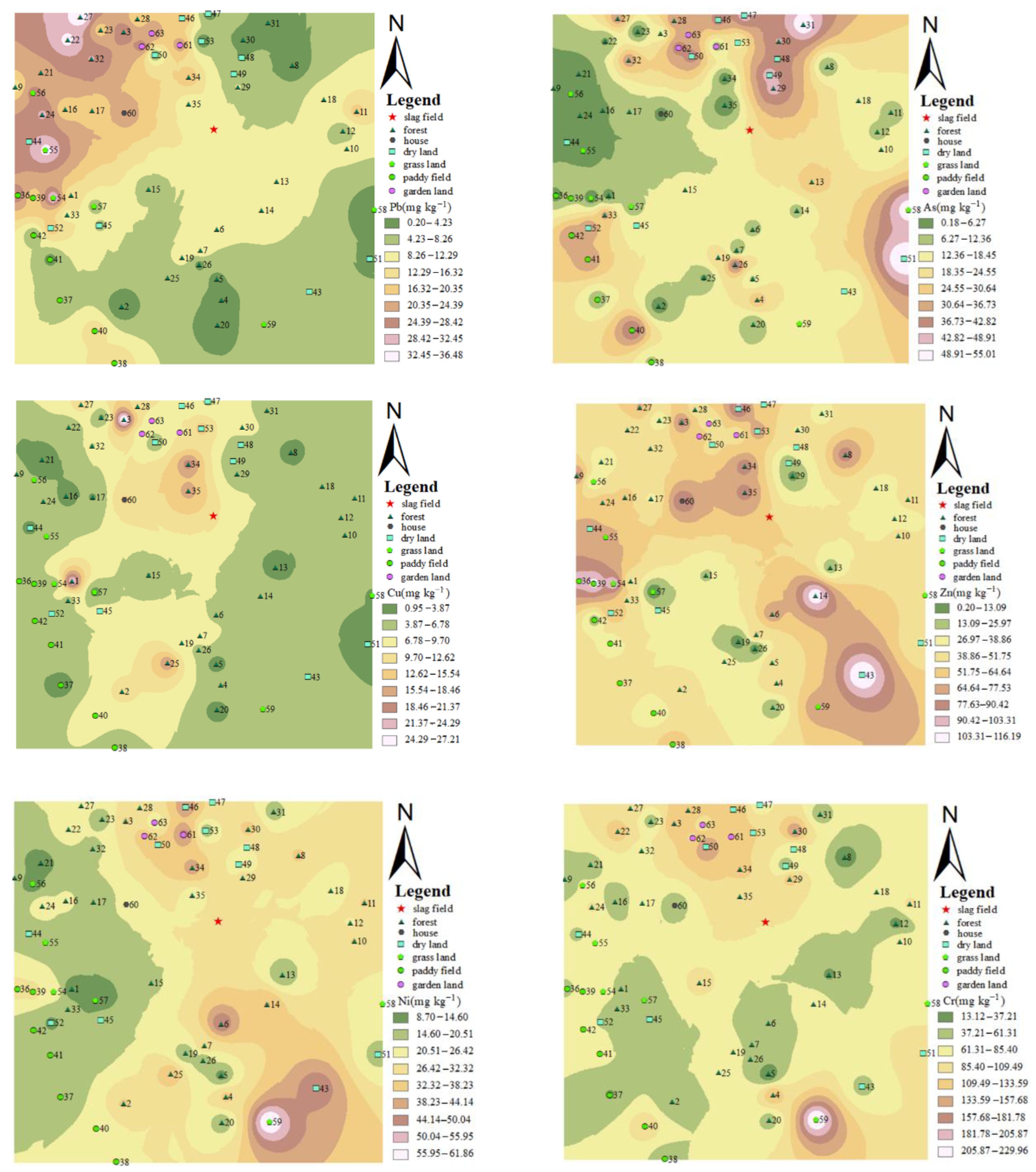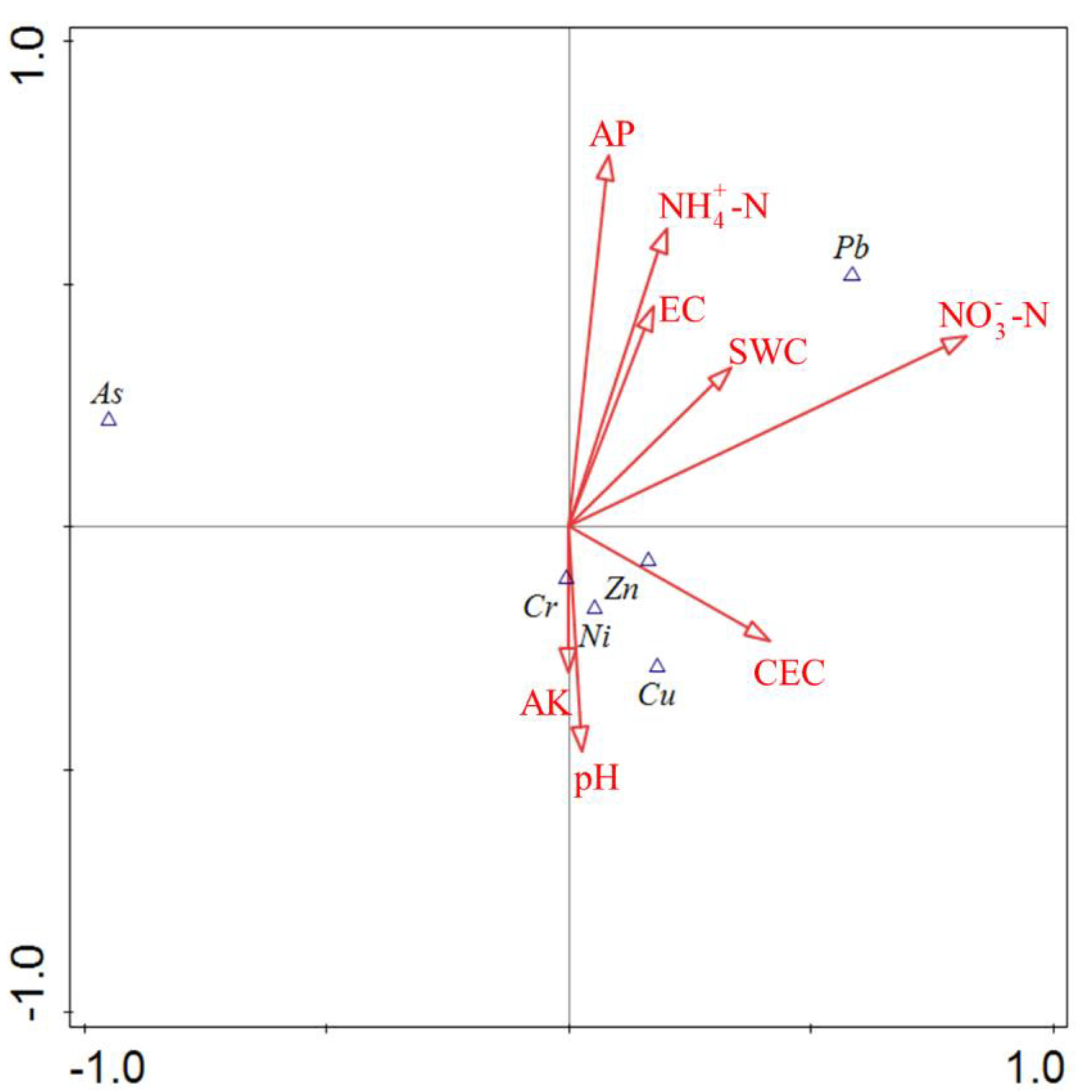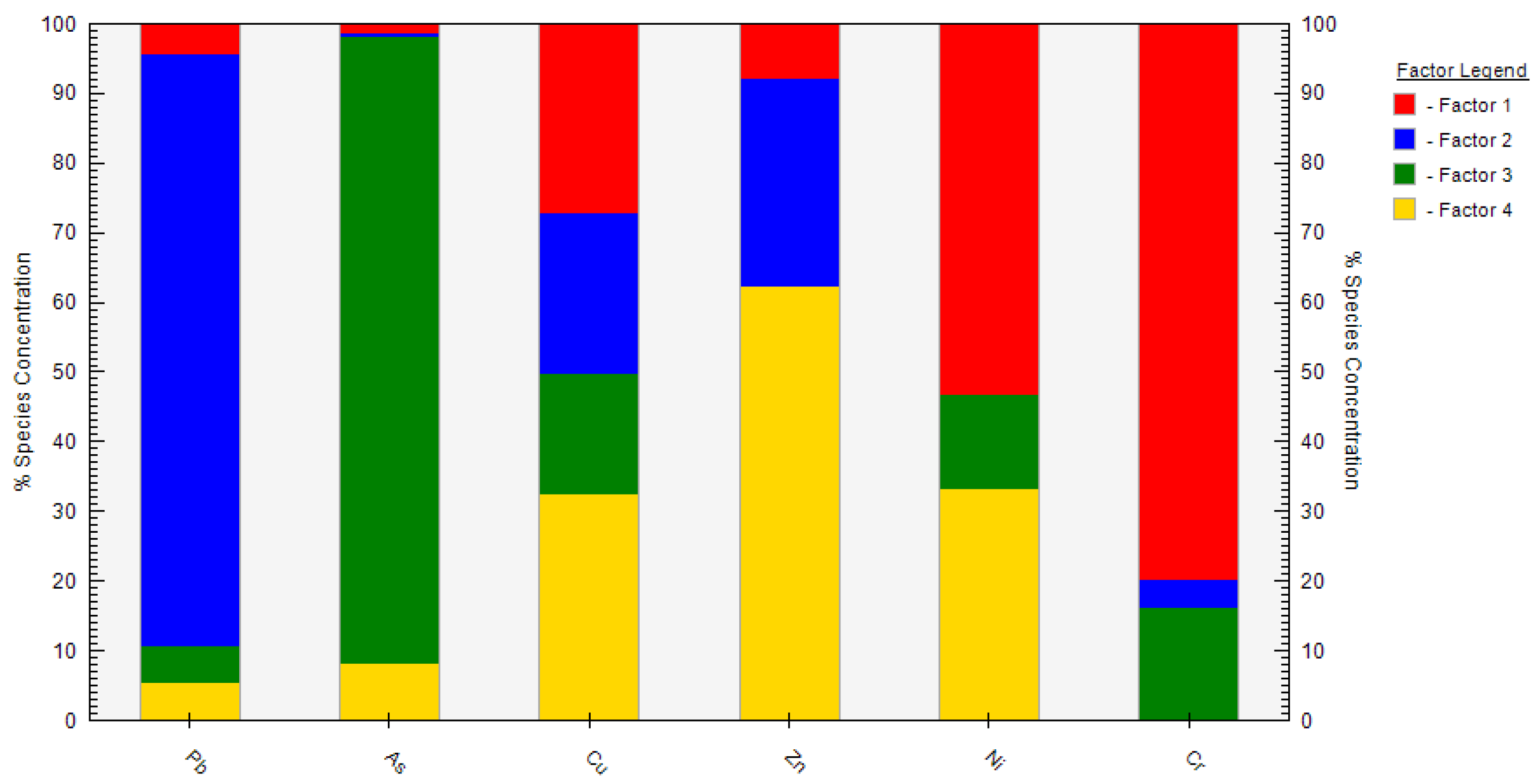Spatial Distribution Characteristics and Source Appointment of Heavy Metals in Soil in the Areas Affected by Non-Ferrous Metal Slag Field in the Dry-Hot Valley
Abstract
:1. Introduction
2. Materials and Methods
2.1. Study Area
2.2. Sample Collection and Treatment
2.3. Data Evaluation
2.3.1. Evaluation of Soil Heavy Metal Pollution
2.3.2. Soil heavy Metal Inverse Distance Weighting (IDW) and Comprehensive Evaluation
2.3.3. Correlation Analysis
2.3.4. Positive Matrix Factorization Model (PMF)
3. Results and Discussion
3.1. Descriptive Statistics of Soil Heavy Metals and Physicochemical Properties
3.2. Risk Evaluation
3.2.1. Risk Assessment of Heavy Metal Pollution in Soil
3.2.2. Comprehensive Evaluation of Soil Heavy Metal Pollution
3.3. Source and Pollution Degree of Heavy Metals in Soil
3.3.1. Relationships between Environmental Factors and Heavy Metals
3.3.2. Source Analysis of PMF Model
4. Conclusions
Author Contributions
Funding
Informed Consent Statement
Data Availability Statement
Conflicts of Interest
References
- Broda, J.; Franitza, P.; Herrmann, U.; Helbig, R.; Grosse, A.; Grzybowska-Pietras, J.; Rom, M. Reclamation of abandoned open mines with innovative meandrically arranged geotextiles. Geotext. Geomembr. 2020, 48, 236–242. [Google Scholar] [CrossRef]
- Gujre, N.; Mitra, S.; Soni, A.; Agnihotri, R.; Rangan, L.; Rene, E.R.; Sharma, M.P. Speciation, contamination, ecological and human health risks assessment of heavy metals in soils dumped with municipal solid wastes. Chemosphere 2020, 262, 128013. [Google Scholar] [CrossRef] [PubMed]
- Adimalla, N.; Chen, J.; Qian, H. Spatial characteristics of heavy metal contamination and potential human health risk assessment of urban soils: A case study from an urban region of south India. Ecotox. Environ. Saf. 2020, 194, 110406. [Google Scholar] [CrossRef] [PubMed]
- Duan, X.W.; Zhang, G.L.; Rong, L.; Fang, H.Y.; He, D.N.; Feng, D.T. Spatial distribution and environmental factors of catchment-scale soil heavy metal contamination in the dry-hot valley of Upper Red River in southwestern China. Catena 2015, 135, 59–69. [Google Scholar] [CrossRef]
- Liu, X.; Wang, X.; Wang, D.Y. Spatial distribution trends and influencing factors of typical heavy metals in subtropical alpine forest soils: A case study from Ailao mountain in Yunnan province. Environ. Sci. 2021, 42, 3507–3517. [Google Scholar]
- Hai, X.Z.; Ang, Z.C.; Xiao, J.W.; Li, T.W.; Qing, W.; Xiao, Q.W.; Ying, Q.M. Risk Assessment and Source Apportionment of Heavy Metals in Soils from Handan City. Appl. Sci. 2021, 11, 9615. [Google Scholar]
- Yang, H.R.; Wang, F.E.; Yu, J.; Huang, K.; Zhang, H.C.; Fu, Z.H. An improved weighted index for the assessment of heavy metal pollution in soils in Zhejiang, China. Environ. Res. 2021, 192, 110246. [Google Scholar] [CrossRef]
- Ahn, J.M.; Kim, S.; Kim, Y.S. Selection of priority management of rivers by assessing heavy metal pollution and ecological risk of surface sediments. Environ. Geochem. Health 2020, 42, 1657–1669. [Google Scholar] [CrossRef] [PubMed]
- Li, K.J.; Gu, Y.S.; Li, M.Z.; Zhao, L.; Ding, J.J.; Lun, Z.J.; Tian, W. Spatial analysis, source identification and risk assessment of heavy metals in a coal mining area in Henan Central China. Int. Biodeter. Biodegr. 2018, 128, 148–154. [Google Scholar] [CrossRef]
- Lv, J.S. Multivariate receptor models and robust geostatistics to estimate source apportionment of heavy metals in soils. Environ. Pollut. 2019, 244, 72–83. [Google Scholar] [CrossRef]
- Guan, Q.Y.; Wang, F.F.; Xu, C.Q.; Pan, N.H.; Lin, J.K.; Zhao, R.; Yang, Y.Y.; Luo, H.P. Source apportionment of heavy metals in agricultural soil based on PMF: A case study in Hexi Corridor, Northwest China. Chemosphere 2018, 193, 189–197. [Google Scholar] [CrossRef] [PubMed]
- Luo, X.S.; Xue, Y.; Wang, Y.L.; Cang, L.; Xu, B.; Ding, J. Source identification and apportionment of heavy metals in urban soil profiles. Chemosphere 2015, 127, 152–157. [Google Scholar] [CrossRef]
- Paatero, P.; Tapper, U. Positive matrix factorization: A non-negative factor model with optimal utilization of error estimates of data values. Environmetrics 1994, 5, 111–126. [Google Scholar] [CrossRef]
- Fairbrother, A.; Wenstel, R.; Sappington, K.; Wood, W. Framework for metals risk assessment. Ecotox. Environ. Saf. 2007, 68, 145–227. [Google Scholar] [CrossRef] [PubMed]
- Martin, M.; Bonifacio, E.; Hossain, K.M.J.; Huq, S.M.I.; Barberis, E. Arsenic fixation and mobilization in the soils of the Ganges and Meghna floodplains. Impact of pedoenvironmental properties. Geoderma 2014, 228, 132–141. [Google Scholar]
- Johanne, N.; Hodson, M.E.; Stuart, B. A review of studies performed to assess metal uptake by earthworms. Environ. Pollut. 2007, 145, 402–424. [Google Scholar]
- Wei, J.; Zheng, X.G.; Liu, J.T.; Zhang, G.W.; Zhang, Y.X.; Wang, C.L.; Liu, Y.C. The Levels, Sources, and Spatial Distribution of Heavy Metals in Soils from the Drinking Water Sources of Beijing, China. Sustainability 2021, 13, 3719. [Google Scholar] [CrossRef]
- Ma, J.; Liu, P.; Liu, J.Z.; Guo, C.H.; Zhang, X.; Wang, L.H. Pollution Evaluation and Quantitative Traceability Analysis of Heavy Metals in Farmland Soils around the Gangue Heap of Coal Mine, Chongqing. Environ. Sci. 2022. [Google Scholar] [CrossRef]
- Zhong, X.; Chen, Z.W.; Li, Y.Y.; Ding, K.B.; Liu, W.S.; Liu, Y.; Yuan, Y.Q.; Zhang, M.Y.; Baker, A.J.M.; Yang, W.J.; et al. Factors influencing heavy metal availability and risk assessment of soils at typical metal mines in Eastern China. J. Hazard. Mater. 2020, 400, 123289. [Google Scholar] [CrossRef]
- Zhang, Y.M.; Li, S.; Chen, Z.; Wang, F.; Chen, J.; Wang, L.Q. A systemic ecological risk assessment based on spatial distribution and source apportionment in the abandoned lead acid battery plant zone, China. J. Hazard. Mater. 2018, 354, 170–179. [Google Scholar] [CrossRef] [PubMed]
- Friedman, S.P. Soil properties influencing apparent electrical conductivity: A review. Comput. Electron. Agric. 2005, 46, 45–70. [Google Scholar] [CrossRef]
- Yang, Q.Q.; Li, Z.Y.; Lu, X.N.; Duan, Q.N.; Huang, L.; Bi, J. A review of soil heavy metal pollution from industrial and agricultural regions in China, Pollution and risk assessment. Sci. Total Environ. 2018, 642, 690–700. [Google Scholar] [CrossRef]
- Zhang, X.; Yang, H.H.; Cui, Z.J. Migration and speciation of heavy metal in salinized mine tailings affected by iron mining. Water Sci. Technol. 2017, 76, 1867–1874. [Google Scholar] [CrossRef] [PubMed]
- Sun, J.W.; Yu, R.L.; Hu, G.R.; Jiang, S.H.; Zhang, Y.F.; Wang, X.M. Bioavailability of heavy metals in soil of the Tieguanyin tea garden, southeastern China. Acta Geochim. 2017, 36, 519–524. [Google Scholar] [CrossRef]
- Paatero, P.; Eberly, S.; Brown, S.G.; Norris, G.A. Methods for estimating uncertainty in factor analytic solutions. Atmos. Meas. Technol. 2014, 7, 781–797. [Google Scholar] [CrossRef]
- Hu, Y.A.; Cheng, H.F. Application of stochastic models in identification and apportionment of heavy metal pollution sources in the surface soils of a large-scale region. Environ. Sci. Technol. 2013, 47, 3752–3760. [Google Scholar] [CrossRef]
- Hu, Y.A.; Liu, X.P.; Bai, J.M.; Shih, K.M.; Zeng, E.Y.; Cheng, H.F. Assessing heavy metal pollution in the surface soils of a region that had undergone three decades of intense industrialization and urbanization. Environ. Sci. Pollut. R. 2013, 20, 6150–6159. [Google Scholar] [CrossRef]
- Cheng, H.F.; Hu, Y.N. Lead (Pb) isotopic fingerprinting and its applications in lead pollution studies in China: A review. Environ. Pollut. 2010, 158, 1134–1146. [Google Scholar] [CrossRef]
- Dong, B.; Zhang, R.Z.; Gan, Y.D.; Cai, L.Q.; Freidenreich, A.; Wang, K.P.; Guo, T.W.; Wang, H.B. Multiple methods for the identification of heavy metal sources in cropland soils from a resource-based region. Sci. Total Environ. 2019, 651, 3127–3138. [Google Scholar] [CrossRef]
- Xiao, R.; Guo, D.; Ali, A.; Mi, S.S.; Liu, T.; Ren, C.Y.; Li, R.H.; Zhang, Z.Q. Accumulation, ecological- health risks assessment, and source apportionment of heavy metals in paddy soils: A case study in Hanzhong, Shaanxi, China. Environ. Pollut. 2019, 248, 349–357. [Google Scholar] [CrossRef]
- Lv, J.S.; Liu, Y. An integrated approach to identify quantitative sources and hazardous areas of heavy metals in soils. Sci. Total Environ. 2019, 646, 19–28. [Google Scholar] [CrossRef] [PubMed]
- Hu, Y.N.; He, K.L.; Sun, Z.H.; Chen, G.; Cheng, H.F. Quantitative source apportionment of heavy metal(loid)s in the agricultural soils of an industrializing region and associated model uncertainty. J. Hazard. Mater. 2020, 391, 122244. [Google Scholar]
- Yang, S.Y.; He, M.J.; Zhi, Y.Y.; Chang, S.X.; Gu, B.J.; Liu, X.M.; Xu, J.M. An integrated analysis on source-exposure risk of heavy metals in agricultural soils near intense electronic waste recycling activities. Environ. Int. 2019, 133, 105239. [Google Scholar] [CrossRef] [PubMed]
- Hu, Y.A.; Cheng, H.F.; Tao, S.; Schnoor, J.L. China’s ban on phenylarsonic feed additives, a major step toward reducing the human and ecosystem health risk from arsenic. Environ. Sci. Technol. 2019, 53, 12177–12187. [Google Scholar] [CrossRef] [PubMed]
- Zhao, W.; Cheng, H.F.; Tao, S. Structure-reactivity relationships in the adsorption and degradation of substituted phenylarsonic acids on birnessite (δ-MnO2). Environ. Sci. Technol. 2020, 54, 1475–1483. [Google Scholar] [CrossRef] [PubMed]
- Zeng, X.F.; Wang, Z.W.; Wang, J.; Guo, J.T.; Chen, X.J.; Zhuang, J. Health risk assessment of heavy metals via dietary intake of wheat grown in Tianjin sewage irrigation area. Ecotoxicology 2015, 24, 2115–2124. [Google Scholar] [CrossRef]
- Meng, W.Q.; Wang, Z.W.; Hu, B.B.; Wang, Z.L.; Li, H.Y.; Goodman, R.C. Heavy metals in soil and plants after long-term sewage irrigation at Tianjin China: A case study assessment. Agric. Water Manag. 2016, 171, 153–161. [Google Scholar] [CrossRef]






| Index | Unit | Min | Max | Mean | SD | CV | Background Value |
|---|---|---|---|---|---|---|---|
| Pb | mg·kg−1 | 0.20 | 36.50 | 13.37 | 10.03 | 0.75 | 30.90 |
| As | mg·kg−1 | 0.17 | 55.02 | 19.87 | 16.81 | 0.85 | 10.40 |
| Cu | mg·kg−1 | 0.94 | 27.27 | 6.91 | 5.04 | 0.73 | 30.10 |
| Zn | mg·kg−1 | 0.11 | 116.20 | 50.55 | 27.70 | 0.55 | 86.50 |
| Ni | mg·kg−1 | 8.68 | 61.87 | 25.06 | 10.97 | 0.44 | 32.60 |
| Cr | mg·kg−1 | 12.96 | 230.05 | 77.71 | 39.31 | 0.51 | 79.00 |
| -N | mg·kg−1 | 5.56 | 118.10 | 47.23 | 19.91 | 0.42 | - |
| -N | mg·kg−1 | 28.66 | 381.60 | 157.21 | 84.97 | 0.54 | - |
| AP | mg·kg−1 | 4.92 | 281.20 | 49.60 | 54.93 | 1.11 | - |
| AK | mg·kg−1 | 30.28 | 867.50 | 220.50 | 172.10 | 0.78 | - |
| EC | mS m−1 | 1.43 | 25.04 | 6.92 | 5.33 | 0.77 | - |
| CEC | cmol+ kg−1 | 0.10 | 12.90 | 2.78 | 2.72 | 1.00 | - |
| SWC | % | 4.47 | 47.49 | 20.35 | 6.70 | 0.32 | - |
| pH | - | 3.48 | 7.06 | 5.12 | 0.61 | 0.12 | - |
| Evaluation | Index | First-Order | Second-Order | Tertiary | Four Pole | Five Grades |
|---|---|---|---|---|---|---|
| Single-factor pollution index | Pi | Pi ≤ 1 | 1 < Pi ≤ 2 | 2 < Pi ≤ 3 | Pi > 3 | |
| Degree of pollution | No pollution | Mild pollution | Moderately polluted | Severe pollution | ||
| Pb | 100 | 0.00 | 0.00 | 0.00 | ||
| As | 82.54 | 17.46 | 0.00 | 0.00 | ||
| Cu | 100 | 0.00 | 0.00 | 0.00 | ||
| Zn | 100 | 0.00 | 0.00 | 0.00 | ||
| Ni | 100 | 0.00 | 000 | 0.00 | ||
| Cr | 95.24 | 4.76 | 0.00 | 0.00 | ||
| Nemerow integrated pollution index | PN | PN ≤ 0.7 | 0.7 < PN ≤ 1 | 1 < PN ≤ 2 | 2 < PN ≤ 3 | PN > 3 |
| Degree of pollution | Clean | Slight pollution | Mild pollution | Moderate pollution | Heavy pollution | |
| PN | 69.84 | 26.98 | 3.17 | 0.00 | 0.00 |
| Index | Pb | As | Cu | Zn | Ni | Cr | -N | -N | AP | AK | EC | CEC | SWC | pH |
|---|---|---|---|---|---|---|---|---|---|---|---|---|---|---|
| Pb | 1 | −0.321 * | 0.151 | 0.310 * | −0.027 | 0.135 | 0.332 ** | 0.317 * | 0.350 ** | 0.075 | 0.251 * | 0.095 | 0.256 * | −0.106 |
| As | 1 | −0.146 | −0.300 * | −0.039 | 0.275 * | 0.115 | −0.373 ** | 0.131 | 0.158 | −0.015 | −0.199 | −0.032 | −0.044 | |
| Cu | 1 | 0.227 | 0.190 | 0.243 | −0.033 | 0.034 | 0.026 | 0.377 ** | 0.184 | 0.201 | 0.012 | 0.161 | ||
| Zn | 1 | 0.496 ** | 0.094 | 0.113 | 0.179 | 0.083 | 0.215 | −0.052 | 0.105 | 0.073 | 0.246 | |||
| Ni | 1 | 0.498 ** | 0.108 | −0.077 | −0.194 | 0.002 | −0.215 | 0.080 | 0.068 | 0.306 * | ||||
| Cr | 1 | 0.146 | −0.171 | 0.021 | 0.246 | −0.014 | 0.255 * | 0.027 | 0.154 |
Publisher’s Note: MDPI stays neutral with regard to jurisdictional claims in published maps and institutional affiliations. |
© 2022 by the authors. Licensee MDPI, Basel, Switzerland. This article is an open access article distributed under the terms and conditions of the Creative Commons Attribution (CC BY) license (https://creativecommons.org/licenses/by/4.0/).
Share and Cite
Jia, L.; Liang, H.; Fan, M.; Wang, Z.; Guo, S.; Chen, S. Spatial Distribution Characteristics and Source Appointment of Heavy Metals in Soil in the Areas Affected by Non-Ferrous Metal Slag Field in the Dry-Hot Valley. Appl. Sci. 2022, 12, 9475. https://doi.org/10.3390/app12199475
Jia L, Liang H, Fan M, Wang Z, Guo S, Chen S. Spatial Distribution Characteristics and Source Appointment of Heavy Metals in Soil in the Areas Affected by Non-Ferrous Metal Slag Field in the Dry-Hot Valley. Applied Sciences. 2022; 12(19):9475. https://doi.org/10.3390/app12199475
Chicago/Turabian StyleJia, Liang, Huili Liang, Min Fan, Zhe Wang, Shushu Guo, and Shu Chen. 2022. "Spatial Distribution Characteristics and Source Appointment of Heavy Metals in Soil in the Areas Affected by Non-Ferrous Metal Slag Field in the Dry-Hot Valley" Applied Sciences 12, no. 19: 9475. https://doi.org/10.3390/app12199475





